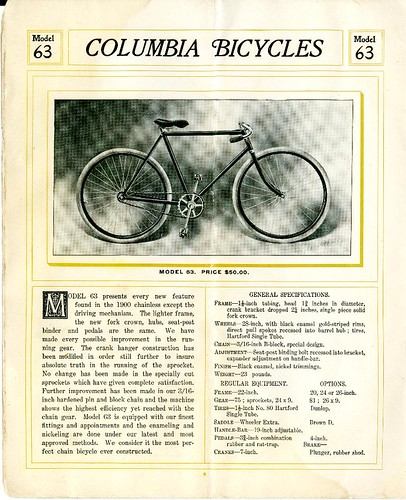I have only reproduced here the text of some representative paragraphs from the beginning, middle and end of the article but it is not very long and may be interesting to read the entire thing.
The introduction is written in a rather overdone style I often see in articles written around this time.
THERE still are those, as there were ten years ago, who persist in their contention that the days of the bicycle are far spent, just as there are those who commune with nature on a spring day with their fingers in their ears and admit the earth is beautiful while they lament that the birds have ceased to sing in the tree tops. And because it takes all manner of people to make a world, there doubtless are those also who confess that wheeling exhales a most seductive influence, but who will resist it for the same reason as of yore; they will wait until bicycles are cheaper. Not while green Nature allures when winter wanes, and mankind enjoys his liberty, will bicycling or some kindred recreation lose its fascination. The industry has felt an impulse to renewed activity, and while it is in a measure true that this spirit of optimism is perennial, the conclusion is so logical that it must be shared by everyone.The article then reviews the history of the bicycle's development and makes the following conclusions:
All sorts of impossible inventions continue to emanate from the patent office, but the prospect of another radical step forward on present approved lines is obscure. Advancement is not an abstract condition which exists as a natural course,and the improvement of the bicycle cannot be said to cover a century, but was rather confined to two decades.Here the writer has in mind bicycles for general use and not a bicycle used by a professional racer, which would have been a much more narrow market at that time. Since then, of course, it has turned out that there can be a great variety of bicycle types overall, but here question was whether there would be some additional leap to improve bicycle technology comparable to the introduction of the pneumatic tire.
There have necessarily been greater variations in the different designs for the last ten years than reason demanded, but the amount of experimentation to which it is attributable has not been without a favorable effect on the present high standard of excellence. Every important feature has been carried to opposite extremes in order to attain the happy medium, and possibly with an ulterior motive of keeping the public curiosity whetted by constantly changing fashions. But now there is no longer need to perpetuate that expensive custom of adopting a radically different design every year, and marking wheels a scant year old down to bargain counter prices. Evolution has been toward uniformity. . .
The article then has the following flowery conclusion:
While prices are not actually increased this year, it augurs well for the quality of the bicycle that there is a tendency to buoyancy in this direction. With the public clamoring for prices lower than the cost of a good bicycle, there was a flood of inferior wheels, cheap in all save price, assembled from a fortuitous medley of unrelated parts and pieces. The sale of assorted parts has decreased, which means that with wheels of established reputation within the reach of all, the profit in home made work is lost."A bicycle is to a motor bicycle as a horse is to the automobile" is not how things have worked out, but the basic logic that the bicycle's "utility appeals to man's commercial instincts" seems to be true for some today at least, if we take "commercial" to mean "it's economical."
So give the bicycle its due. It will live though a few immunes deny it the right. It will bear the same relation to the motor bicycle that the horse does to the automobile. Society will resurrect it as a fad; indeed it may even now be bent upon it since King Edward of England is an enthusiast. And society will eventually drop it again without affecting its stability. For as a leveler of distances between the city pavements and the green of country earth it is a boon to the nature-lover, while its utility appeals to man's commercial instincts.

A good quality bicycle from 1901 at the reduced (from 1897) price of only $50
No comments:
Post a Comment